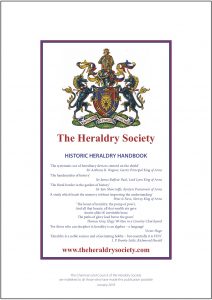 Most people who’ve had any contact with the Society’s College of Arms would recognize the badge of the Heralds — “vert, two straight trumpets in saltire Or” — which may generally be displayed by anyone working for or associated with the College.
Most people who’ve had any contact with the Society’s College of Arms would recognize the badge of the Heralds — “vert, two straight trumpets in saltire Or” — which may generally be displayed by anyone working for or associated with the College.
But there wasn’t a distinctive badge reserved specifically for the artists who assisted the College by illustrating armory, a role that in period was referred to as a “herald painter.” (For more on the history of herald painters, see this essay by Robert Parsons, who held that role for the British College of Arms.) Continue reading “A Badge for Heraldic Artists”

